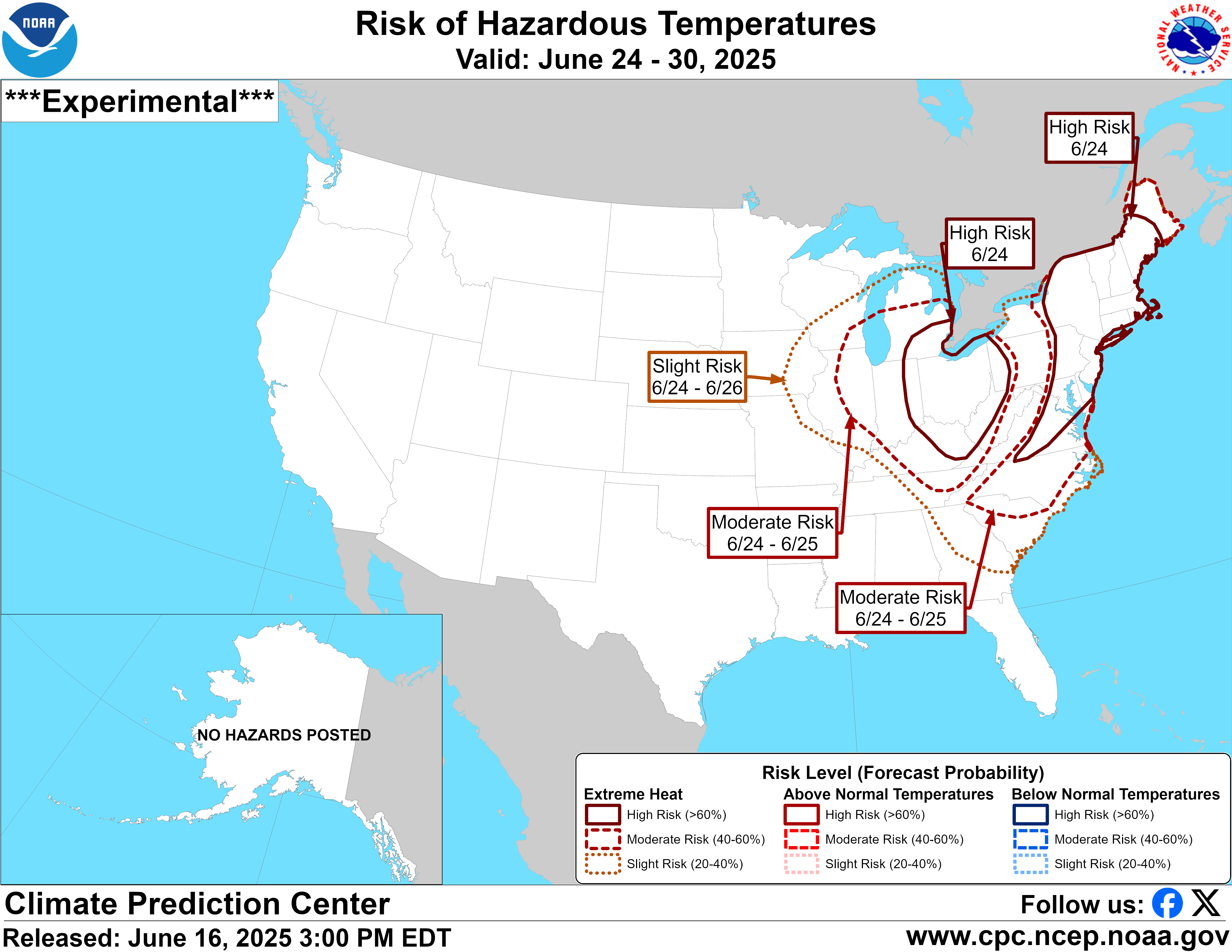
Lucky April 21st to you! Keep up the great work America!
New cases: We have a statistical triple top technically on 4-4, 4-9, 4-10. Odds are high to see lower numbers during the 2nd half of the month-but not every day. Tuesday is coming in lower.

We've turned the corner!
Despite the current pandemic, we still live in the best time of human history. The Coronavirus panic has peaked!
Tracking COVID-19 #3 TUE-4-20-21
https://www.marketforum.com/forum/topic/50858/
Scroll down and enjoy the latest comprehensive weather to the max...... occurring because of the natural physical laws in our atmosphere as life on this greening planet continues to enjoy the best weather/climate in at least 1,000 years(the last time that it was this warm) with the added bonus of extra beneficial CO2.
Reasons to keep being thankful here in 2020!
https://www.marketforum.com/forum/topic/45623/
Winter Weather Forecasts
https://www.wpc.ncep.noaa.gov/wwd/winter_wx.shtml
Go to the link below, then hit the location/county on the map for details.
https://www.spc.noaa.gov/ Go to "hazards"
Here are the latest hazards across the country.
 |
Purple/Pink/blue on land is cold/Winter weather. Brown is wind, Green is flooding. Gray is fog. Reddish is a red flag advisory.
Go to the link below, then hit the location/county on the map for details.
https://www.spc.noaa.gov/ Go to "hazards"
https://www.mesonet.org/index.php/weather/map/us_air_temperature/air_temperature

https://www.mesonet.org/index.php/weather/map/wind_chill_heat_index1/air_temperature

Current Weather Map
| NCEP Days 0-7 Forecast Loop | NCEP Short-Range Model Discussion | NCEP Day 3-7 Discussion |


Current Jet Stream

| Low Temperatures Tomorrow Morning |

Highs today and tomorrow.



Highs for days 3-7:
Warm in the Plains and West this week. Chilly in the Great Lakes/Northeast!!
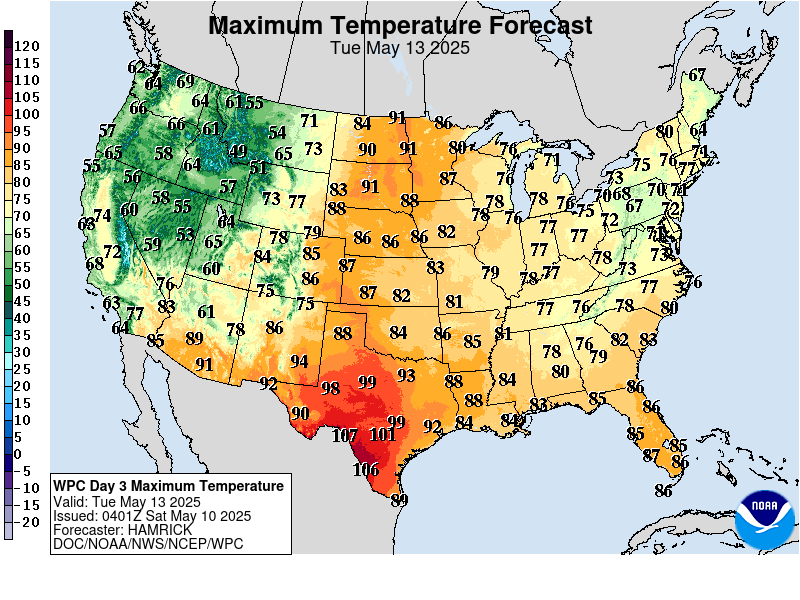
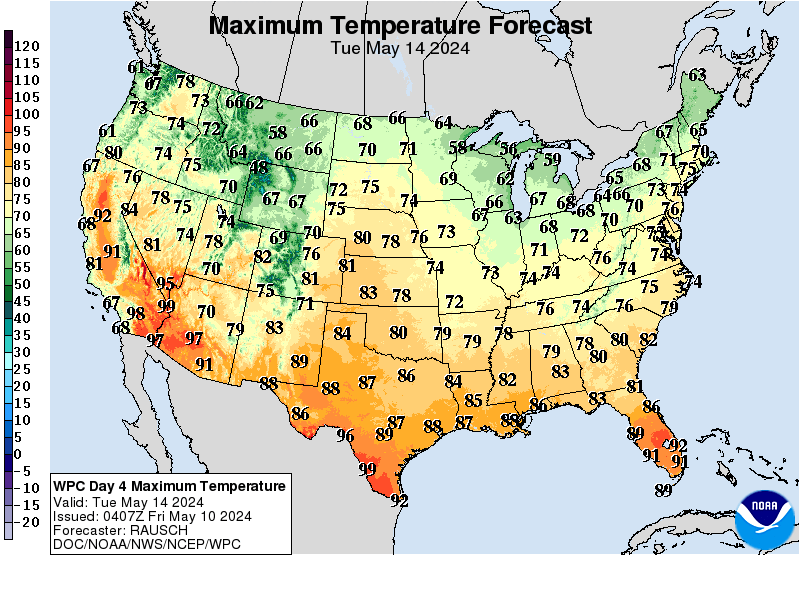
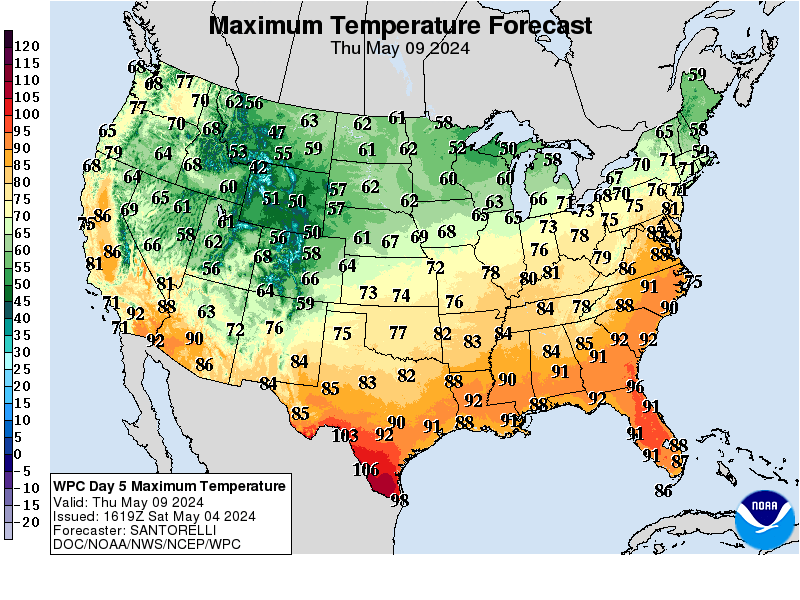
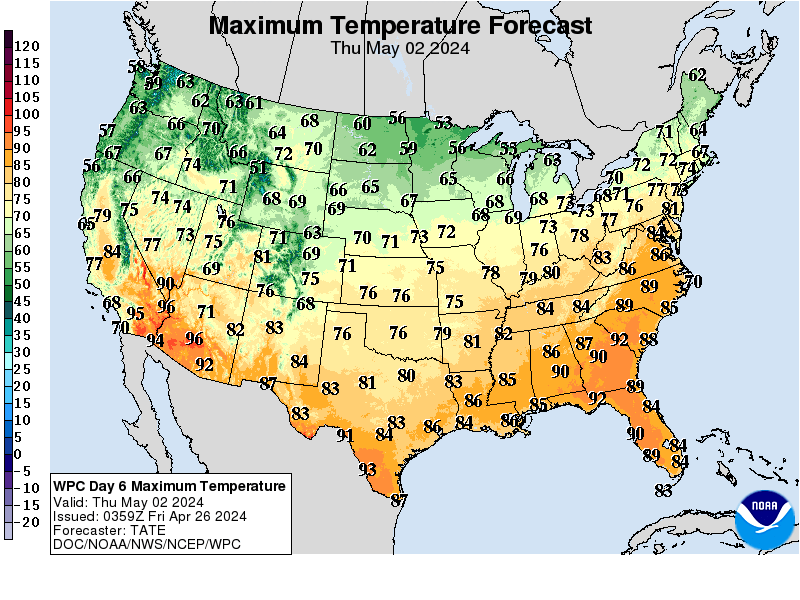
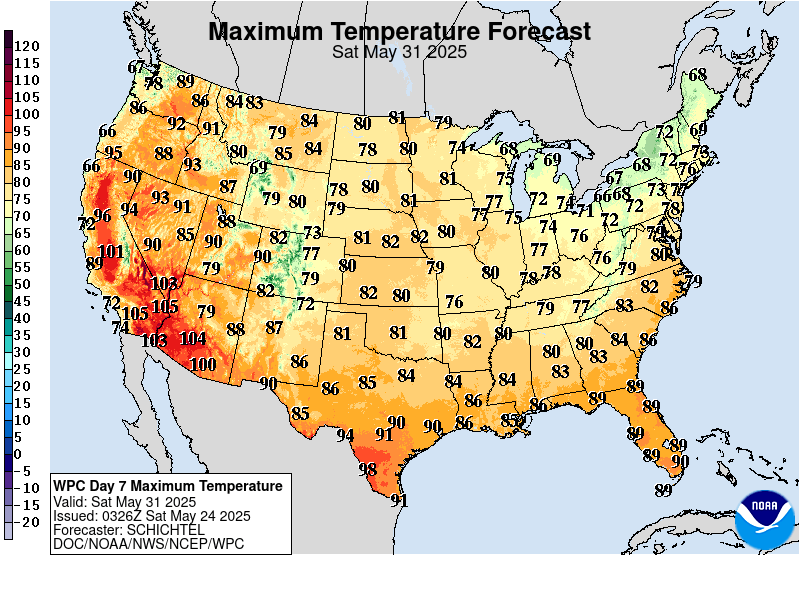
Temperatures compared to Average for days 3-7
Warm reds West to the Plains.......Chilly Blues in the Ohio Valley, Great Lakes and Northeast.
https://www.wpc.ncep.noaa.gov/medr/medr_mean.shtml
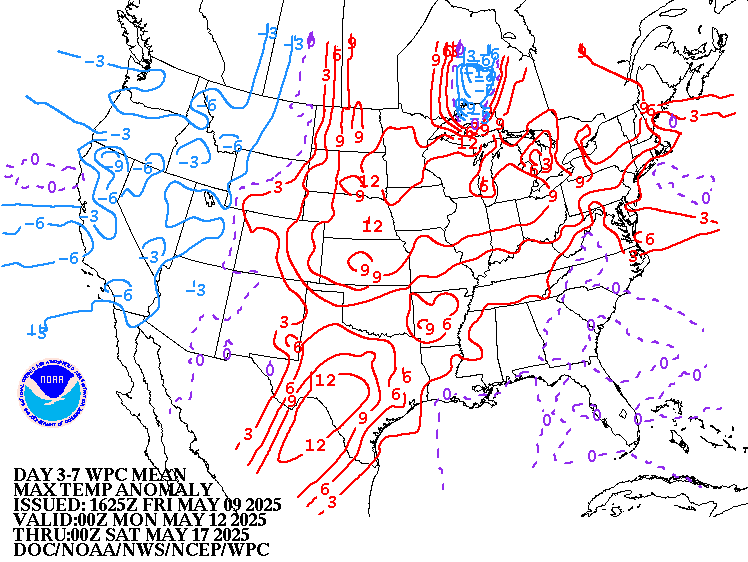
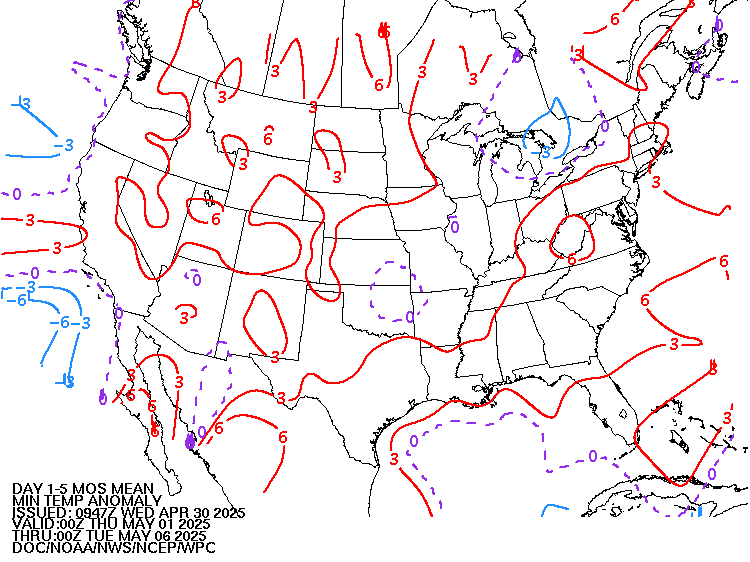
Surface Weather features day 3-7:
A couple of weather systems with more rain than yesterday's forecast, especially southern Midwest but not too heavy.
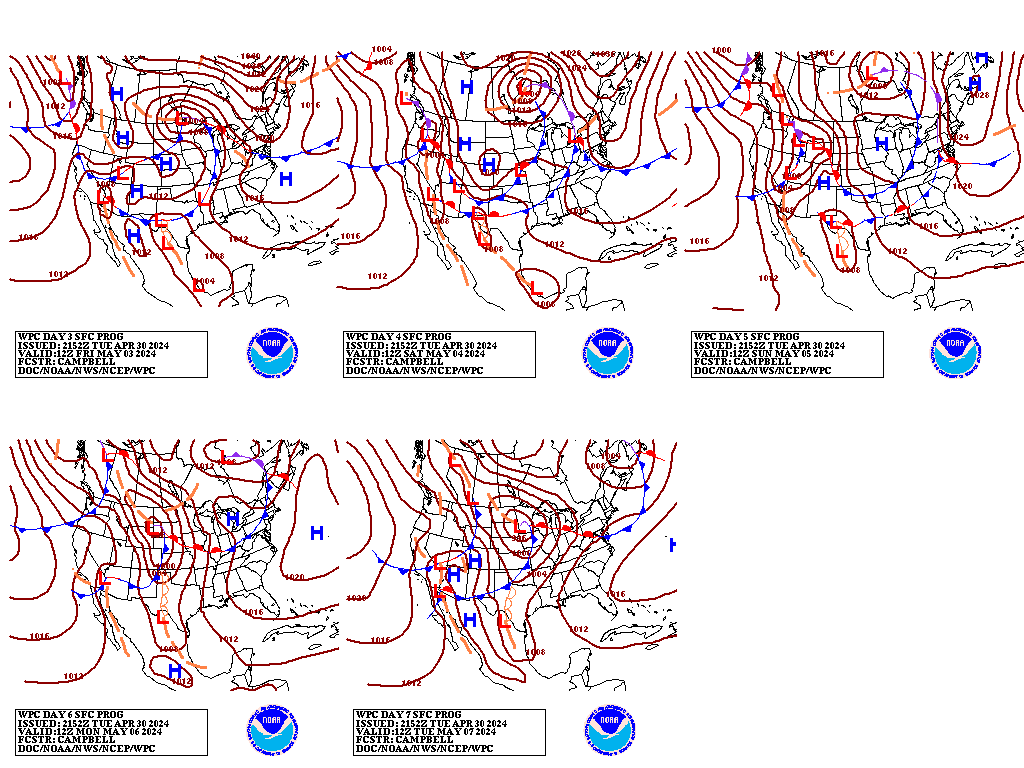
Liquid equivalent precip forecasts for the next 7 days are below.
More rain, the farther south you go in the Midwest...........Less rain, the farther north you go.
Day 1 below:
http://www.wpc.ncep.noaa.gov/qpf/fill_94qwbg.gif?1526306199054
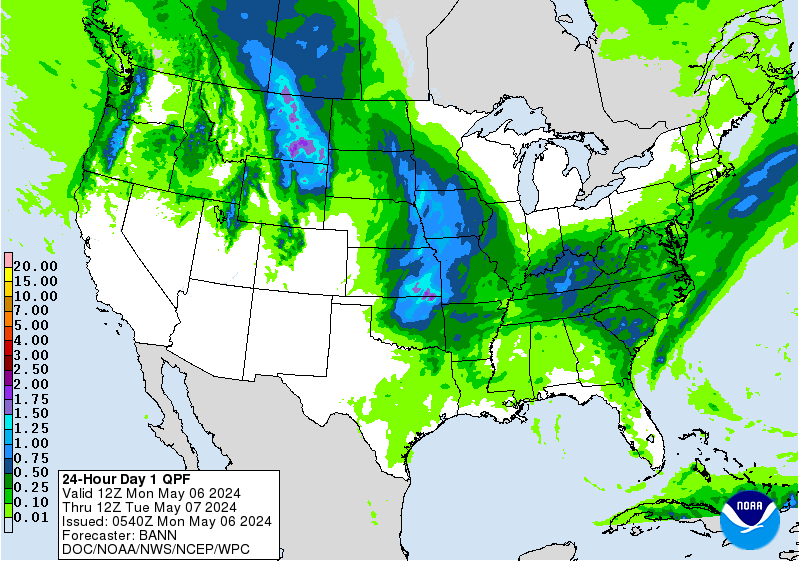
Day 2 below:
http://www.wpc.ncep.noaa.gov/qpf/fill_98qwbg.gif?1528293750112
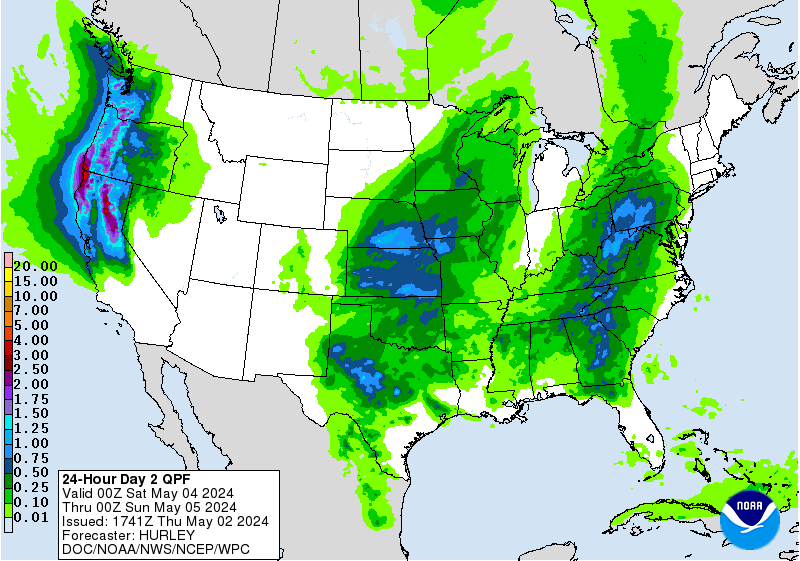
Day 3 below
http://www.wpc.ncep.noaa.gov/qpf/fill_99qwbg.gif?1528293842764
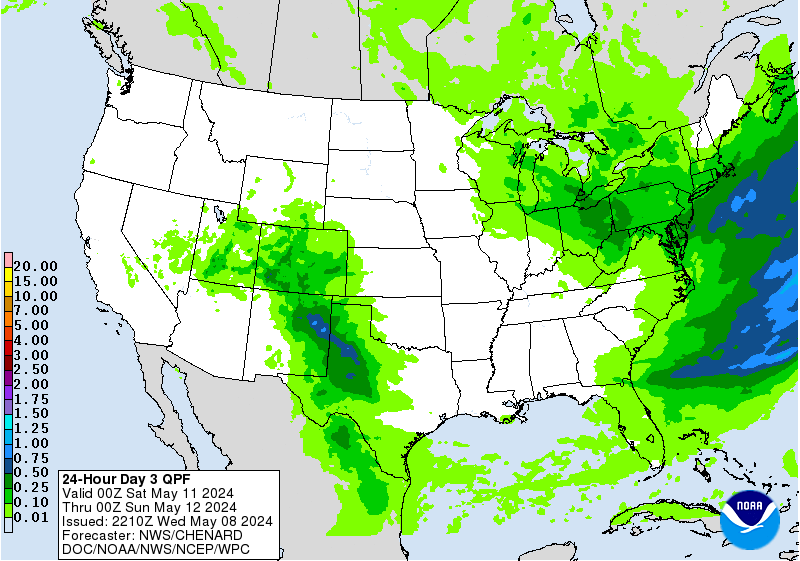
Days 4-5 below:
http://www.wpc.ncep.noaa.gov/qpf/95ep48iwbg_fill.gif?1526306162
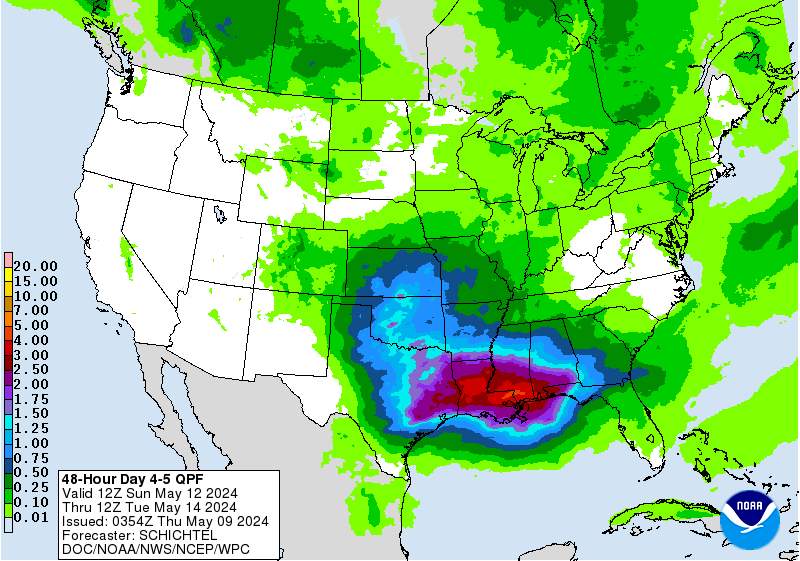
Days 6-7 below:
http://www.wpc.ncep.noaa.gov/qpf/97ep48iwbg_fill.gif?1526306162
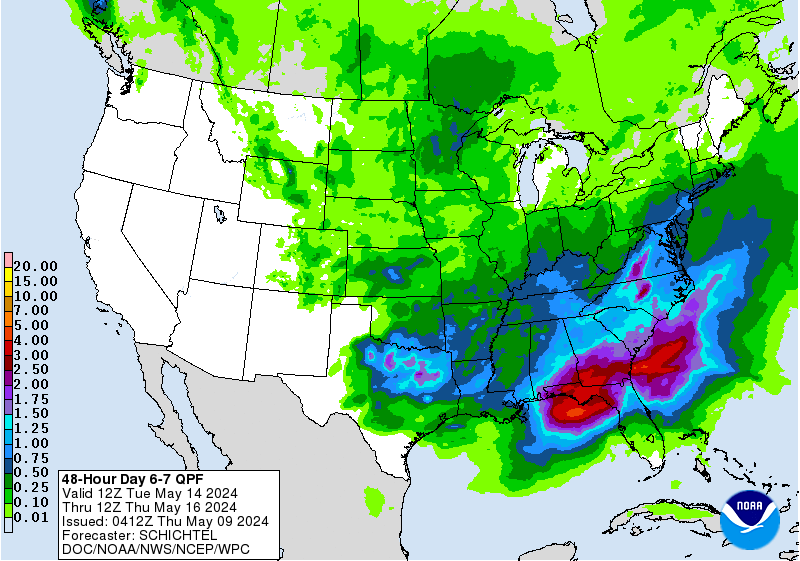
7 Day Total precipitation below:
https://www.wpc.ncep.noaa.gov/qpf/p168i.gif?1566925971
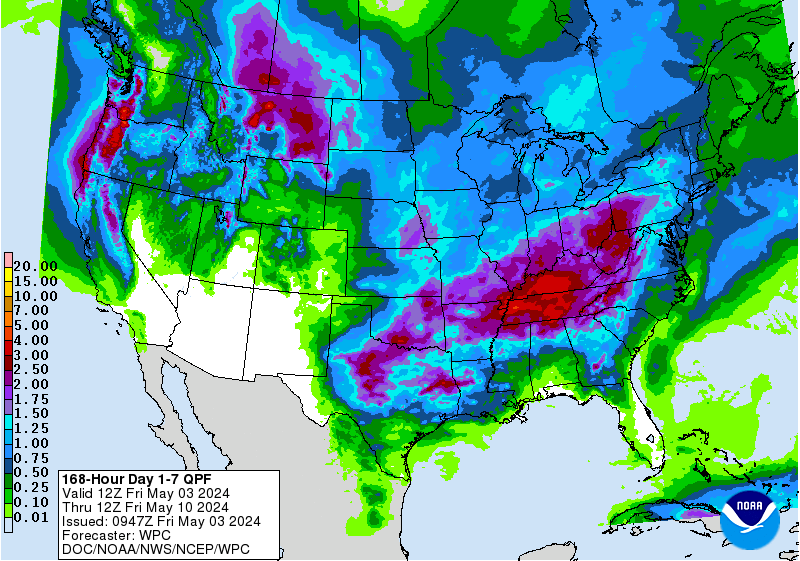
Excessive rain potential.
Drying more in the Upper Midwest. Moderate to Heavy rains S/Southeast US.
Mesoscale Precipitation Discussions
Current Day 1 Forecast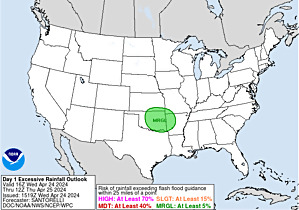 Valid 16Z 08/30/19 - 12Z 08/31/19 |
Day 1 Threat Area in Text Format
| Day 2 and Day 3 Forecasts |
Current Day 2 Forecast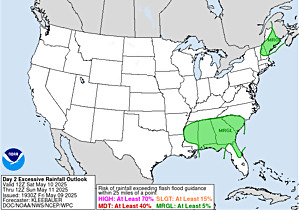 Valid 12Z 08/31/19 - 12Z 09/01/19 |
Day 2 Threat Area in Text Format
Current Day 3 Forecast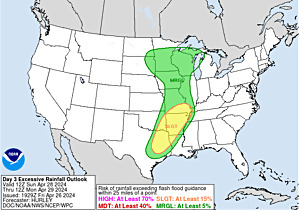 |
Current Dew Points
Dry air/low dew points................that likely helps virus's in the air to survive longer.
Higher dew points cuts down on survival time.
It's thought that doubling the humidity(amount of moisture in the air) will decrease the amount of a virus that survives in the air for 1 hour by 50%. We don't know that for sure with COVID-19.

Latest radar loop
http://www.nws.noaa.gov/radar_tab.php


| (3400x1700 pixels - 2.2mb) Go to: Most Recent Image |

Go to: Most Recent Image
You can go to this link to see precipitation totals from recent time periods:
https://water.weather.gov/precip/
Go to precipitation, then scroll down to pick a time frame. Hit states to get the borders to see locations better. Under products, you can hit "observed" or "Percent of Normal"
Soilmoisture anomaly:
These maps sometimes take a day to catch up to incorporate the latest data(the bottom map is only updated once a week).
Soils in many parts of the Cornbelt have dried out enough for early planting.
Plenty of time to dry out elsewhere and it will dry out in much of the Upper) Midwest for the next week.........as well as warm up in the Plains and Western belt.
https://www.cpc.ncep.noaa.gov/products/Soilmst_Monitoring/US/Soilmst/Soilmst.shtml#
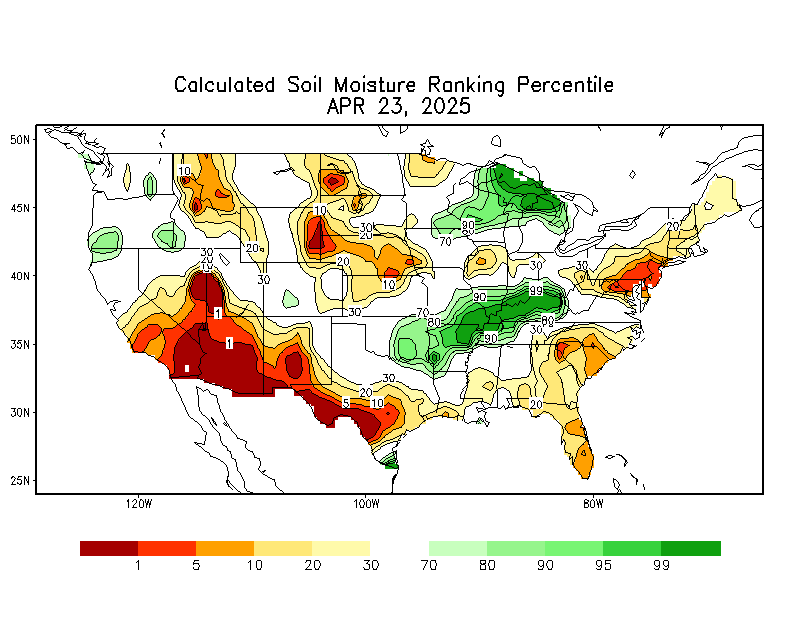
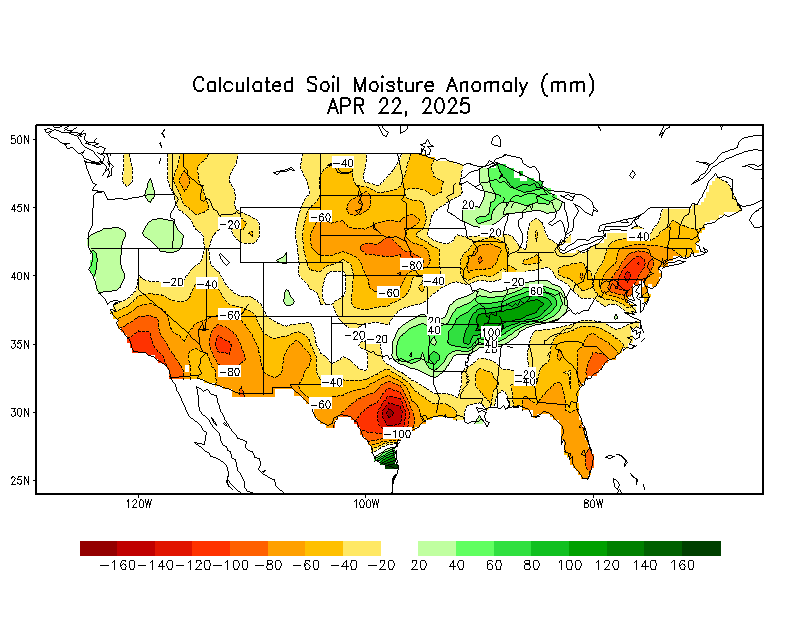
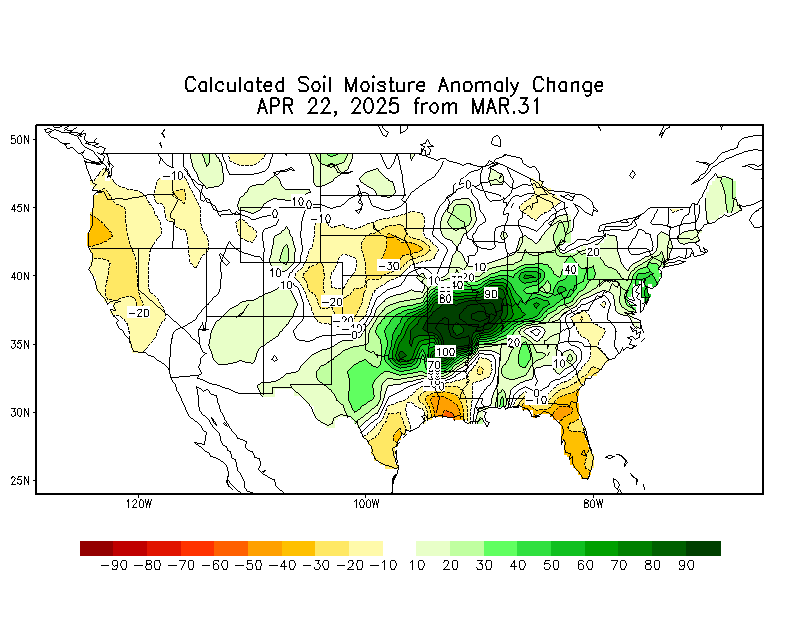
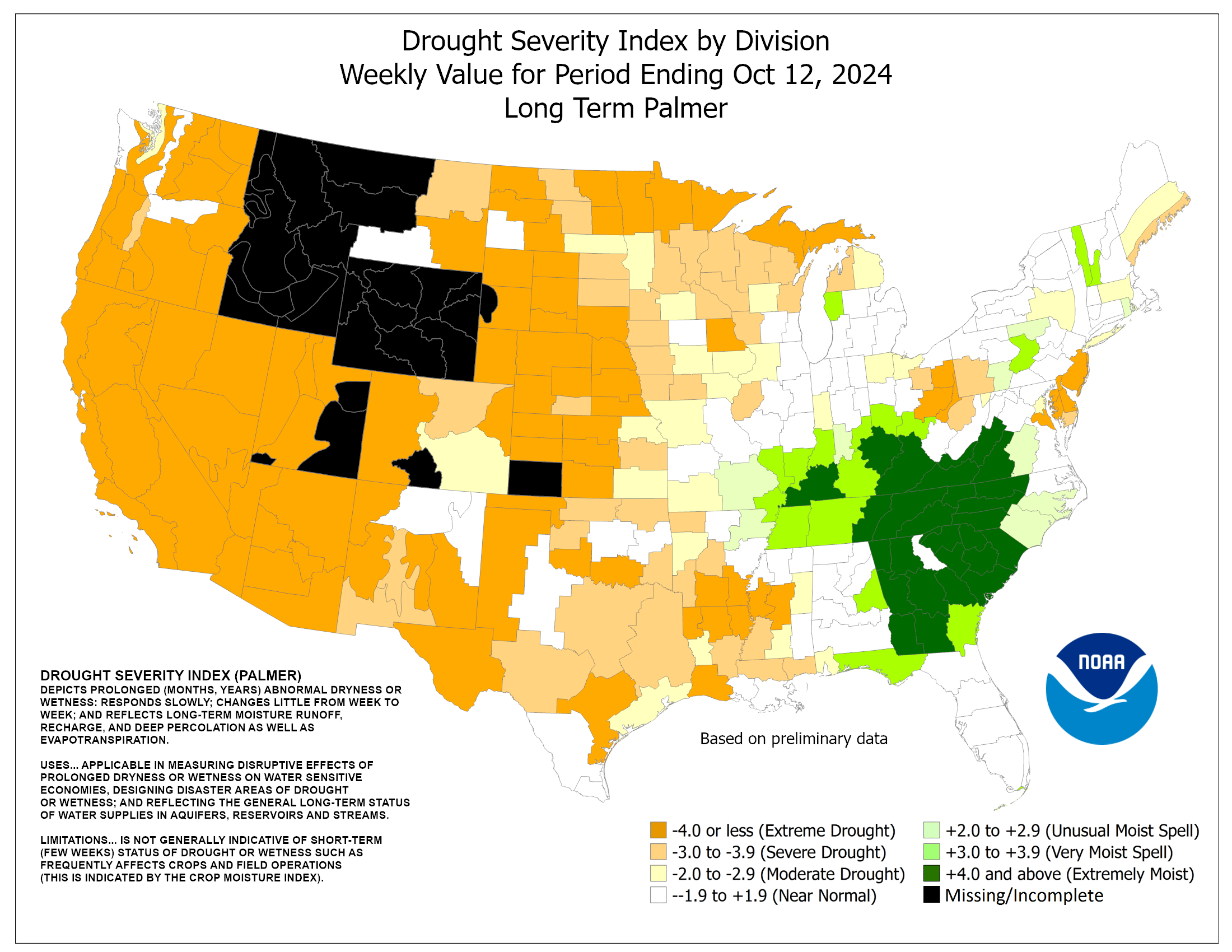

Drought Monitor maps:
Latest: The first map below is the latest. The 2nd one is from last week.
April 16: No drought anywhere in the Midwest. 0% drought there.
The maps below are updated on Thursdays.
https://droughtmonitor.unl.edu/


The top map is the Canadian ensemble average, the maps below are the individual members that make up the average at the end of week 2.
+++++++++++++++++++++++++++++++++++++++++
Each member is like the parent, Canadian model operational model.......with a slight tweek/variation in parameters. Since we know the equations to represent the physics of the atmosphere in the models are not perfect, its useful to vary some of the equations that are uncertain(can make a difference) to see if it effects the outcome and how.
The average of all these variations(ensembles) often yields a better tool for forecasting. It's always more consistent. The individual operational model, like each individual ensemble member can vary greatly from run to run.........and represent an extreme end of the spectrum at times. The ensemble average of all the members, because it averages the extremes.............from opposite ends of the spectrum.........changes much less from run to run.
End of week 2....................0z Canadian ensembles:
Last Tuesday: Zonal flow.
Wednesday: Turning wetter with more active southern stream flow on the majority of solutions. Upper level trough West to Plains.
Thursday: Turning wetter.
Friday: Not as wet today. Zonal average.
Monday: The average looks like it would be wet.................but most of the individual solutions are dry.
Tuesday: The average actually looks drier today........but many of the individual solutions look pretty wet. Several solutions have a chilly northern stream connection in the Midwest/Northeast.
360h GZ 500 forecast valid on May 06, 2020 12 UTC
Forecasts for the control (GEM 0) and the 20 ensemble members (global model not available)
Individual GFS ensemble solutions for the latest 0z run:

GFS Ensemble mean(average of all the individual solutions above). The first map is a mid/upper level map. The 2nd one is a temperatures map at around 1 mile above the surface. These are anomalies(difference compared to average).
NCEP Ensemble t = 360 hour forecast
Last: Wednesday: Positive anomaly Rockies to N.Plains with negative anomaly in E.Pacific and slight negative East Coast. This is much different that the Canadian model and much drier. Also warmer Rockies to the Plains.
Thursday: Slight positive anomaly over the Midwest, so milder.
Friday: No distinct anomalies.
Monday: Modest ridge/positive anomaly western 2/3rd of the country.......warm and dry there. Negative anomaly in the Northeast, chilly temps there.
Tuesday: Same as Monday. Drier than the Canadian model but low confidence in precip.
Latest, updated graph/forecast for AO and NAO and PNA here, including an explanation of how to interpret them...............mainly where they stand at the end of 2 weeks.
https://www.marketforum.com/forum/t
Previous analysis, with the latest day at the bottom for late week 2 period.
Discussions, starting with the oldest below.
Last Saturday: AO positive but drops a bit late. NAO negative but back near 0 late. PNA negative but back near 0 late. Fading influence from these indices that tell us more about the northern stream, as the southern stream becomes more dominant.
Sunday: AO is much lower today, even a few negative solutions, same with the NAO, so there is some support for the chilly air in the Midwest/Northeast to continue longer than the models think. Negative PNA moves towards 0.
Monday: AO drops to around 0, NAO goes up than down both have a wide spread. PNA increases to around 0. Nothing from these indices worth dialing into the upcoming pattern. They are best used during the cold season as northern stream indicators. The -NAO at times does suggest some chilly weather in the Northeast quadrant.
Tuesday: All indices slightly negative. Leaning chilly to the Northeast.
Wednesday: AO, NAO and PNA all near 0.
Thursday: All indices near 0.
Friday: Indices near 0 but NAO leaning negative has me leaning chilly for the Great Lakes/Northeast.
Monday: Indices near 0.
Tuesday: Just like Monday.
National Weather Service 6-10 day, 8-14 day outlooks.
Updated daily just after 2pm Central.
Temperature Probability
| the 8-14 day outlooks ArchivesAnalogsLines-Only FormatGIS Data | |
Temperature Probability | |
 | |
Extreme weather in week 2:
